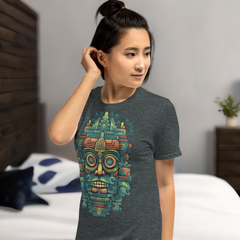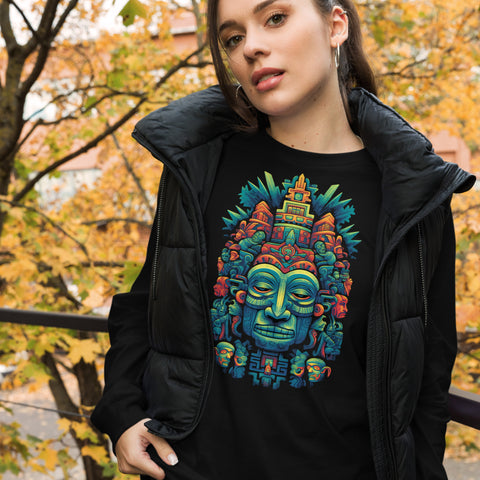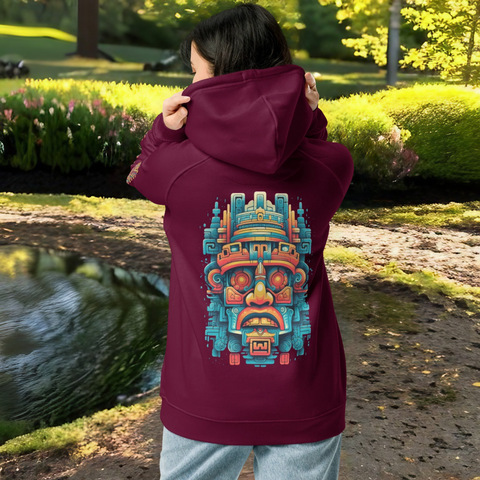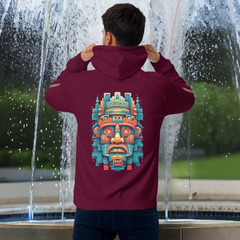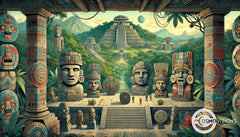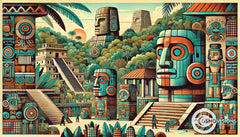Facts About Olmec: Exploring the Civilization for Kids and Beyond
Posted by Massimiliano Geraci

Curiosity often leads us to wonder about the roots and mysteries of ancient Olmec civilizations. Many people, especially kids with a budding interest in history, want to learn more but find the old world complex and hard to grasp.
The Olmec civilization, known as Mesoamerica’s earliest society, sparks many questions due to its fascinating culture and monumental achievements.
One intriguing fact is that the Olmecs established one of their most important cities, San Lorenzo, around 1200 B.C. This blog post aims to peel back layers of time to reveal insights into who the Olmecs were, their society, and why they matter today.
We’ll explore giant stone sculptures and lost cities that tell stories of power and spirituality—making history easy and exciting for young minds! Let curiosity be your guide…
Key Takeaways
1. The Olmecs founded one of Mesoamerica’s earliest civilizations around 1200 B.C. along Mexico’s Gulf Coast, leading the way in art, religion, and governance.
2. Olmec culture thrived along Mexico’s Gulf Coast from roughly 1200 to 400 B.C., marking the earliest great civilization in Mesoamerica.
3. They built majestic cities like San Lorenzo and La Venta, creating giant stone heads from basalt to show their leaders’ power and spirituality.
4. Olmec society was led by powerful leader-priests who controlled both political and spiritual life. Their agricultural practices (like maize cultivation) and religious beliefs influenced later civilizations such as the Maya and Aztecs.
5. Archaeologists have found 17 colossal stone heads near Veracruz and Tabasco that tell stories of the Olmecs’ sophisticated craftsmanship and complex society.
6. The Olmecs left a lasting legacy on Mesoamerican culture through their innovations in farming, architecture, rituals, and art that continue to influence studies about ancient civilizations today.
The dawn of olmec civilization in Mesoamerica
Transitioning from an introduction to the Olmec’s background, we now explore the beginnings of their civilization in Mesoamerica. The Olmecs set up one of the earliest societies along Mexico’s Gulf Coast around 1200 B.C., marking a significant chapter in human history.
This period saw them establish San Lorenzo, their first major city, laying down the cultural and architectural foundations of ancient Olmec culture for future generations.
Their society blossomed from 1200 to 400 B.C., during which they forged a path as pioneers in art, religion, and governance that would greatly influence later civilizations like the Maya and Aztec.
Artifacts such as colossal stone heads sculpted from basalt stand as mute testimony to their ingenuity and artistic vision. These creations, alongside advancements in maize cultivation, showcase an advanced society capable of monumental architecture and sophisticated agricultural practices long before others in the region.
Understanding olmec society and culture
The Olmec people built a strong society ruled by leader-priests. From 1100 to 800 B.C.E., they traded far and wide, sharing goods across Mesoamerica. Their leaders were powerful, guiding their communities’ political and spiritual lives. Their religious beliefs included worship of various Olmec gods, such as the Feathered Serpent and Maize God, which influenced their daily lives and rituals.
This kind of leadership ensured that the Olmecs stood at the forefront of civilization in their time. The heart of any civilization is its people and their beliefs. Olmec families worked hard. They fished, hunted, and later grew maize along with other crops. This shift to farming shows how they adapted over time to improve life. The artifacts they left behind—like massive stone heads, baby-faced figures, and “were-jaguars”—tell us about their art skills and beliefs.
These items weren’t just decorations; they held deep meanings for the Olmec, linking them with nature and the divine.

Significance of olmec heartland in present-day Mexico
Olmec heartland, now in southern Veracruz and Tabasco, holds deep stories from the past. This area was home to rich jungles and rivers where the Olmecs built their cities long ago.
These places, like San Lorenzo and La Venta, show us how advanced they were. They made big stone heads and created systems for farming that we still learn from today.
Exploring these old sites gives clues about early Mexican culture. Archaeologists digging here find tools, figurines, and monuments that link today's Mexico to its ancient roots. Learning from these findings helps keep history alive for everyone.
Now, look at one of their most mysterious creations: the colossal heads.
The Mystical Olmec Colossal Heads: Monuments of Ancient Power
Crafted from massive stone, these heads stand as silent watchers of history. Each one tells a story of power and mystery from the Olmec civilization, known as Mesoamerica’s first great society. These heads are prime examples of Olmec artistic styles, which influenced later Maya and Aztec works.
Carvers transported stones over 50 miles to create them. This feat shows their dedication and skill.
Seventeen heads have been found near Veracruz and Tabasco, near the Gulf of Mexico. They bear different expressions but share a common style that reflects Olmec art. These faces might show rulers who were important in their society.
Their creation speaks volumes about the culture that made them centuries ago.
The story behind the massive stone heads and their creation
The journey from the mystical power of the Olmec colossal heads leads us to their origins. Artists in ancient Mesoamerica carved these giant sculptures straight from rock. They chose stones from locations as far as 50 miles away.
This task demanded not only strength but also deep reverence for their subjects.
Often seen as kings or powerful beings, these heads held great significance. Each one tells a story of leadership and authority within the Olmec society. Imagine moving these massive boulders without modern machinery.
The people used logs, ropes, and sheer human will to transport them across rivers and jungles to their final resting places in what is now known as Veracruz and Tabasco states in Mexico.
Through sweat and determination, they created monumental symbols that still fascinate us today.
Archaeological discoveries of olmec colossal heads in Veracruz and Tabasco
Scientists found 17 big stone heads in Veracruz and Tabasco, Mexico. These heavy sculptures show us the Olmec people's skill long ago. Each head is different and tells a story from ancient times.
These heads stand as silent witnesses to the Olmec civilization's grandeur.
These discoveries were made in places like San Lorenzo and La Venta. The heads have unique features that make experts think they represent powerful leaders of the Olmec society. These finds help us learn about Mexico's first big civilization.
Deciphering the symbolism of olmec art and colossal heads
Olmec art and their giant stone heads hold many secrets. Each work tells a story, showing gods, animals, or mysterious figures like the "were-jaguars." These pieces were more than just decorations.
They showed beliefs and power in Olmec society. The colossal heads, crafted from single blocks of stone, might represent actual rulers or important beings from their spiritual world.
Archaeologist Peter Joralemon linked these arts to eight supernatural beings in Olmec culture. This suggests that each sculpture could connect to a specific deity or mythological concept.
For example, the "were-jaguar" may symbolize fertility or creation myths within their religion. Understanding these symbols helps us see how deeply spirituality was woven into daily life for the first great Mesoamerican civilization.
Next, we'll explore how the Olmec influenced later cultures like the Maya and Aztec.
Olmec Contributions to Later Mesoamerican Civilizations
Moving from the fascinating world of Olmec art and its colossal heads, we see their vast influence on cultures that came after. The Olmecs paved the way for societies like the Maya, the Aztecs, and others in Central America.
They shared their knowledge in farming corn and other crops, which became a cornerstone for those who followed. This mastery of agriculture fed growing populations and supported ambitious projects.
Their spiritual beliefs deeply touched later civilizations too. Ideas about gods and sacred rituals found roots in Olmec traditions. These early practices shaped religious ceremonies across Mesoamerica long after the Olmecs themselves had faded into history.
Through these contributions, the legacy of this "mother culture" continued to enrich and guide new generations exploring spirituality and community life under the sun of Mexico's Gulf Coast.
How olmec civilization influenced the Maya and Aztec cultures
The Olmec civilization laid the groundwork for many aspects of Maya and Aztec cultures. Their expertise in maize cultivation spread throughout Mesoamerica, fostering agricultural practices that became staples for later civilizations.
The Olmecs also introduced monumental architecture and detailed art styles, seen in the massive stone sculptures and intricate jade carvings adopted by their successors. This blending of innovation set a precedent, proving essential to developing complex societies in ancient Mexico.
The legacy of Olmec innovation lives on in every corner of Mesoamerican culture.
The influence is unmistakable in religion and spirituality. The concept of powerful deities and elaborate rituals originated with the Olmecs and then spread to the intricate mythologies of the Maya and Aztecs.
Symbols like the famed Olmec Dragon permeated through these cultures, illustrating a shared spiritual heritage that underscores their connection to this ancient mother culture. Through these enduring legacies, it's clear that without the pioneering advancements of the Olmecs, much of what we admire about Maya and Aztec civilizations might not have existed.
The legacy of olmec innovation in maize cultivation and other agricultural practices
After exploring how the Olmec civilization influenced the Maya and Aztec cultures, it becomes clear that their innovative approaches to farming, especially maize cultivation, laid a strong foundation for agriculture in Mesoamerica. In addition to their agricultural practices, the Olmecs also developed unique pottery techniques that were adopted by other Mesoamerican cultures.
They were among the first to turn fishing and hunting groups into farming communities. This shift not only changed their diet by adding crops like maize but also transformed socio-economic structures.
Olmec farmers developed techniques that made plants grow better and yield more food. These methods included irrigation systems to water crops and early forms of terrace farming to prevent soil erosion on hillsides.
Their knowledge in selecting seeds for planting ensured bountiful harvests of maize, which became a staple food for civilizations that followed. Such agricultural practices spread far beyond the Olmec heartland, influencing generations long after their cities fell into ruin.
Tracing the olmec's impact on mesoamerican culture and religion
The Olmec civilization, known as the "mother culture" of Mesoamerica, left a lasting mark on later societies like the Maya and Aztec. Their religious figures, such as the Feathered Serpent, Maize God, and Water God became central to these cultures' beliefs.
This sharing shows how deeply the Olmec influenced their neighbors. They introduced key agricultural techniques too, especially in maize cultivation. These innovations spread far and wide, shaping the entire region's development.
Their art and symbols also carried deep spiritual meanings that later civilizations adopted. For instance, massive stone sculptures captured both human and divine essences, inspiring awe across ages.
Through these creations, the spiritual world of the Olmecs lived on in Mesoamerican memory. Cities like San Lorenzo became centers where this rich cultural tapestry unfolded daily amongst temples and bustling markets—a testament to a civilization that profoundly shaped its successors.
Exploring the Olmec’s Hidden Cities: San Lorenzo and La Venta
Moving from the spiritual and cultural legacies, we now focus on the Olmec's architectural prowess. San Lorenzo and La Venta stand as testaments to this ancient civilization's engineering skills.
Established around 1200 B.C., San Lorenzo was one of their first urban achievements. Here, daily life buzzed within a complex society structured by distinct social classes.
La Venta took center stage after San Lorenzo's decline, showcasing monumental architecture that still captivates researchers today. This site reveals secrets about how the Olmecs lived, worshipped, and governed themselves.
Both cities highlight the Olmec’s skill in creating durable structures that have lasted for centuries. These places offer us a window into an era where grand ideas were etched in stone and dirt.

Daily life and societal organization in olmec cities
As we move from uncovering the secrets of San Lorenzo and La Venta, we delve into the rhythms of everyday life in Olmec cities. People led lives closely tied to nature and the earth.
They fished, hunted, and later grew maize among other crops. This connection with the land was vital for their survival and shaped much of their daily life.
The Olmecs structured their society to support this way of life. At its core were families that worked together in farming and trading across Mesoamerica. Important people in these communities likely organized trade routes and ensured crops grew well.
There wasn't just one person in charge; leadership was more spread out. Everyone had a role that kept their city running smoothly, proving how interconnected their personal lives were with societal needs.
The archaeological significance of San Lorenzo and La Venta as olmec centers
Moving on from daily life and societal organization, we delve into the importance of San Lorenzo and La Venta. These places stand out as vital centers for the Olmec. They were among the earliest cities in Mesoamerica, with San Lorenzo taking shape around 1200 B.C.E.
This timing is crucial because it marks the beginning of complex societies in the region.
San Lorenzo and La Venta are like open books that tell us how advanced the Olmecs were. Archaeologists found giant stone heads here, showing the faces of ancient rulers or gods. These sites also give clues about Olmec art, beliefs, and ways of building.
For example, at La Venta, a massive earthen pyramid proves they could move huge amounts of earth to create sacred spaces.
San Lorenzo and La Venta: Windows into the soul of early Mesoamerican civilization.
Revealing the secrets of olmec architectural and engineering marvels
The Olmecs showed great skill in building. They made aqueducts to move water and crafted a huge pyramid at La Venta known as Complex C. This shows they knew a lot about engineering.
They even moved stone over 50 miles to build the San Lorenzo heads. This was hard work but showed their determination.
Their cities, like San Lorenzo and La Venta, were full of these wonders. The big stone heads tell stories of powerful leaders. Each head had its own look and detailed different characters.
These creations make us see how advanced the Olmecs were long ago.
The Spiritual World of the Olmecs: Gods, Rituals, and the Olmec Dragon
The Olmecs worshipped many gods, showing their deep spiritual life. Peter Joralemon, an archaeologist, found eight major divine beings in this ancient culture. These included powerful figures like the Feathered Serpent and the Maize God.
Their beliefs left a lasting mark on cultures that came after them, such as the Mayans and Aztecs.
Their rituals were complex and meaningful, often centered around important symbols like the Olmec Dragon. This creature represented power and how they understood the world around them.
Amazing archaeological finds provide evidence of these practices, showing how religion played a central role in every part of Olmec life.
Understanding the role of religion in olmec civilization
Moving from the spiritual landscape to the core beliefs, religion played a vital part in Olmec life. This ancient community saw their world as filled with gods and spirits. They believed these divine forces controlled everything from the weather to crops growing in fields.
Religion was not just a belief system; it shaped every aspect of daily life.
Olmec shamans, who were both leaders and religious figures, connected the people with the supernatural world. These ruler-shamans performed ceremonies and rituals to appease gods or ask for favors.
Key deities like the Feathered Serpent represented fertility and creation, while others influenced rain and agriculture. Through art, we glimpse into their religious practices — colossal stone heads might represent revered gods or ancestor spirits, showing us how deeply spirituality wove into the fabric of Olmec society.
Identifying key olmec deities and the symbolism of the olmec dragon
The Olmec civilization worshipped many gods, with eight supernatural beings standing out. Archaeologist Peter Joralemon shared this insight, showing us how deep their beliefs ran. These deities included figures like the Feathered Serpent, Maize God, and Water God.
Each one held special power over aspects of life and nature, influencing later cultures such as the Maya and Aztec.
One fascinating symbol from the Olmec religion is the Olmec dragon. This creature wasn't a dragon in the way we think of today but represented important qualities like earth, agriculture, and fertility.
Its image combines features of jaguars and serpents to show strength and connection to water sources.
Next comes an exploration into archaeological finds that shed light on these practices.
Archaeological evidence of olmec religious practices and rituals
Archaeologists found many clues about Olmec religious practices and rituals. They discovered stone monuments, pottery, and carvings showing gods and supernatural beings. These items tell us how the Olmec worshiped their gods.
Peter Joralemon identified eight key deities in the Olmec pantheon, including powerful figures like the Feathered Serpent and Maize God.
Olmec artifacts give us more insight into their spiritual world. For example, ceremonial sites in Veracruz and Tabasco had large sculptures that likely participated in religious events.
These places were not just centers of power but also spaces for connecting with the divine. These discoveries show how much later Mesoamerican cultures owed to the Olmecs' spiritual innovations.
Olmec Rulers and Society: Governance and Social Hierarchy
Moving from the spiritual to the political, the Olmec civilization showcased a complex structure of governance led by powerful leaders. These leaders were part shaman, part ruler, holding sway over their communities with both religious and royal authority.
They wielded power in temples and across vast lands, guiding their people according to ancient customs.
Within this society, classes emerged that defined one's place in the world. At the top stood the ruling families, revered for their divine connection and leadership. Below them were artisans and farmers, each contributing to society with their skills in crafting monumental sculptures or cultivating crops like maize.
These social divisions underscored a hierarchy deeply rooted in both spirituality and function, reflecting an intricate tapestry of interdependence among members of Olmec society.
The political structure and roles of rulers in olmec society
Shifting focus to the political framework, Olmec society thrived under a centralized authority. This system was led by ruler-shamans who combined political power with religious influence.
These leaders held significant sway over their communities, guiding them in worldly affairs and spiritual matters.
Olmec rulers showcased their power through massive stone sculptures and elaborate ceremonies. They were seen as intermediaries between the earthly realm and the divine, making important decisions that affected every aspect of daily life.
Their roles were crucial in maintaining order and ensuring prosperity throughout the Olmec civilization, highlighting a sophisticated governance structure for such an ancient society.
Class and social hierarchy within the Olmec civilization
Moving from the political structure to societal organization reveals a complex class system. The Olmec civilization had rulers at the top, known as ruler shamans. These leaders held both spiritual and political power, guiding their people through rituals and decisions.
They came from powerful families that controlled society.
Beneath the ruler-shamans were skilled workers including artists and farmers. Artists created massive stone heads and other sculptures that have amazed people for centuries. Farmers grew maize and other crops, feeding the civilization and enabling it to grow.
Most of Olmec society consisted of common people, who worked hard to support their community under the guidance of their leaders.

The legacy of olmec rulers through monumental stone sculptures and artifacts
Olmec leaders left a lasting mark with their enormous stone works and ancient items. These creations show us the power and skill of the first Mesoamerican civilization. They carved 17 giant stone heads, each one telling a story of their reign and spiritual beliefs.
Alongside these, they also made figures that look like babies and were-jaguars, blending human traits with powerful animal forms.
These monumental pieces were guardians of Olmec lands, placed at significant sites like San Lorenzo and La Venta. Craftspeople used tools made from harder stones to shape these sculptures, showing off their advanced techniques in working with massive stones.
These artifacts link today's people to the Olmecs' complex society, letting us learn about their culture, religion, and daily life thousands of years ago.
FAQs
1. Who were the Olmec, and where did they live?
The Olmec lived long ago, around 1200 to 400 BCE. They made their homes in what we now call Mexico, near the Gulf Coast and in places like Veracruz and Tabasco. Imagine living in a world so old!
2. What is so special about Olmec sites like Tres Zapotes?
Places like Tres Zapotes are windows into the past... Here, we can see huge stone heads and learn how the Olmecs built their cities near rivers.
3. Did anything force the Olmec to move their homes?
Yes! Sometimes life got tough because of changes in weather or other problems... So, they had to find new places to live that were safer for them.
4. What kinds of things did the Olmec make?
They created amazing art, from gigantic stone sculptures that show us powerful faces from long ago to pottery that tells stories without words.
5. Can you tell me about any gods or beliefs they had?
The Olmec believed in many gods... These beliefs shaped their lives daily and inspired much of their incredible artwork.
6. How do we know all this about the Olmec today?
Thanks to archaeologists digging up old objects and studying ancient writings...we can piece together stories of these first great builders in America.




